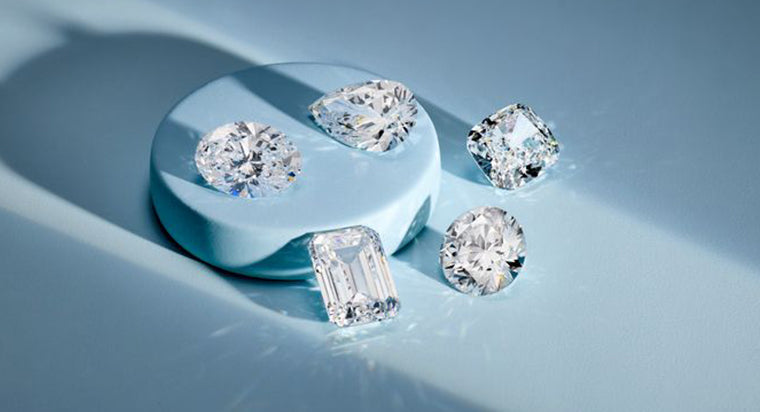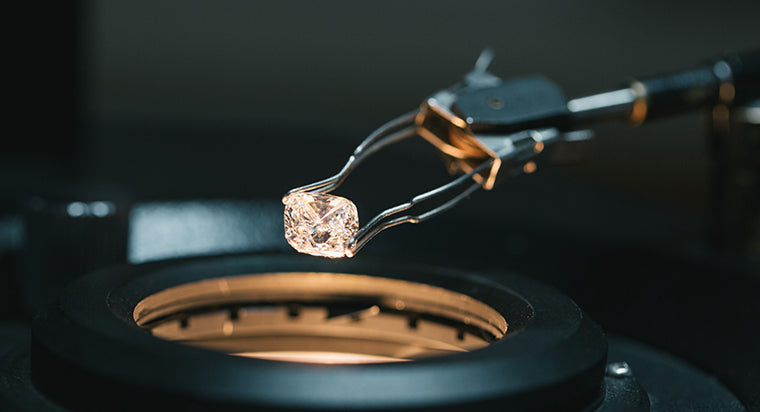Rose Cut vs Antique Cut vs Brilliant Cut Diamonds

Diamonds come in a variety of shapes and sizes. Over time diamond cutting has become a standardized science producing uniformly cut diamonds that are beautiful in appearance and comparable in value. As diamond cutting has developed, the look and sparkle of diamonds has been accentuated by these different techniques.

TABLE OF CONTENTS
Rose Cut Diamonds
The rose cut diamond dates all the way back to the 1500s, making it one of the oldest diamond shapes in the world, but most people have not even heard of it. What is a rose cut diamond? This particular cut gets its name from the way in which the stones are positioned. They resemble a rose petal by the way in which they attempt to mimic the spiral of a rose. This cut is usually flat at the bottom which gives the stone more surface area to become more brilliant. Although this diamond cut fell out of favor due to more brilliant cuts, it is, once again, rising in popularity among the engagement ring crowd.
Rose cut diamonds these diamonds resemble crystal bits that were cut in a triangle with patterns that resemble a honeycomb. Rose cut diamond possess enough charm to enable them to be the preferred style of diamonds in Europe. Rose cut diamonds are made by the jeweler, who would technically be responsible for the brilliance with a rose cut diamond shines. The rose cut diamond presents a more fashionable diamond cut method. It was discovered in the 18th to the 19th century, but lost its popularity when the cuts that were more brilliant came into existence. The rose cut diamond comes in two forms: single rose cut and rose cut with additional layers of diamond facets. The single cut has a single layer and can be surrounded by smaller diamonds, while the double layer in the stone is centered. Rose cut diamonds typically do not have flat bottoms. The ones that are high, or deep are also known as a double rose cut diamond or Dutch rose cuts. Many possess horizontal facets and these facets range from structured, down to naive. Antique diamond cuts in the rose shape are not perfectly rounded as they were often hand-cut.

Antique Cut Diamonds
Long ago, diamond cutters used to employ techniques, which are no longer being used now. When they cut the diamonds by hand, it gave them different shapes, or dimensions, which would capture the essence of that era. The old techniques that were used to cut these diamonds would make them less brilliant, but they emitted a warm and romantic aura. Antique diamonds go in and out of popularity, as their look is unique.
Antique cut diamonds are much more open-ended with style. In fact, this term refers to the general essence of the stone instead of the shape it takes. Antique cut diamonds cannot be reproduced today. These stones are solely found as heirloom pieces because they were cut by hand one-by-one. Nowadays, all of the stones are cut by a machine, and therefore, there is a factory-like precision on each and every stone.

Brilliant Cut Diamonds
Earlier in the 1900 century, diamond cutters experimented with several new techniques. They got a breakthrough at around 1919 when the round brilliant cut was introduced. Because of sparkle it showed off, the round brilliant cut diamond has now become the standard at which diamonds are being cut. Round brilliant cut diamonds have circular girdles and 58 facets. What the round brilliant cut diamond lacks, is culet, but it was made popular in the retro and art deco periods.
The brilliant cut diamond was a conscious effort of jewelers trying to invent a stone that gave off even more shine. Although this was originally a tactic of the jewelers to make more money, people fell in love with brilliant cut diamond engagement rings. In fact, they fell so in love with the diamond shape that brilliant cut diamond rings knocked rose cut diamonds out of the running for the most popular ring. In fact, once jewelers figured out what is a brilliant cut diamond, rose cut diamond engagement rings become almost obsolete.
Cut Origins
Diamond cutting history is somewhat obscure, as it is uncertain when it all began. The most prominent sign is diamond cutting, which began in Venice in the thirteenth century. Of late, several diamond styles and cuts exist and have certain parameters, which govern the style and quality. In the earlier days, this was limited to the tools that were used for cutting. The earliest known diamond cuts were point cut and table cuts, which were very simple. The point cut diamonds were made using the natural lines of the diamond, and the table cut the first diamond with which faceting was used. Another cut followed the table cut in 1940 and was known as the emerald cut. Venice was the first country that had a diamond cutting center, but the center was shifted by the time the 15th century ended. Brussels, Paris and Antwerp became the primary centers for polishing, located in Europe. In these cities, mills that cut diamonds were focused on new ways of polishing and cutting the rough stones.
By the 16th century, new tools, which enabled the cutting of transition and rose cuts were developed. During this time the faceting process began to boom, and resulted in different shapes being invented. Queen Mary of Scots presented a gift to her cousin, the then queen, Queen Elizabeth I, a diamond ring that was in the shape of a heart. Claw prongs were first used as settings for securing the diamonds in jeweler and rings in 1600. Up until the 18th century, the production of the diamond introduced the cushion cut and the old mine cut diamonds. Diamond cutting has been more creative in this century, as Louis XV of France once had his jeweler cut a diamond to resemble a smile, and this is currently known as the Marquise diamond.
Just like old mine cut diamonds, the old European cut diamonds which are cut into this particular shape have a small table, a high crown and a culet that is large and flat. There is a circular girdle that is endemic to the old European cut, it also has 58 facets and is a later design to the round brilliant cut. The old European cut diamond is from the 18th century and was popular during the Art Nouveau, Victorian and Edwardian eras.
Currently, table cut and brilliant cut diamonds are the most popular. However, rose and mine cut diamonds have also retained popularity as people gravitate towards vintage inspired looks. For engagement rings, the most popular diamond cut remains the brilliant cut.
Cut Popularity
In terms of popularity, the brilliant cut diamond is the most popular of the three. This stone produces unmatchable shine that buyers love while still remaining beautiful and affordable. Rose cut diamonds are definitely the least popular of the three because they never truly bounced back after brilliant cut diamonds gained its popularity. Antique cut diamonds are situated somewhere in the middle in terms of popularity. While many buyers love antique cut diamonds, they cannot afford the price of such a historic object. Therefore, many buyers opt to purchase an antique-style cut diamond. These diamonds are cut in the same style as actual antique cut diamonds, but they are still created through today's technology. Therefore, today's mimicking of the antique cut diamonds is lackluster compared to the real deal because real antique cut diamonds vary in shape and size immensely due to the imperfections of cutting by hand. By reproducing antique cut diamonds today, the factory sameness tends to take some of the thrill of the stone away, making it a less popular choice than a brilliant cut diamond. Although not very popular, the antique rose cut diamond ring is an interesting blend between two of these diamond shapes in order to show off something old that cannot truly be remade.
Cut Benefits
Knowing the benefits of one diamond cut, as opposed to another are important for anyone who is even remotely interested in buying a diamond. Diamonds may have a similar look, or style, to the average person, but there are distinct benefits to owning each. Even if the diamond is described as a round cut, they have placement, shape and brilliance that differ significantly. Owning a modern, round diamond, or the round brilliant cut diamond is one of, if not the most popular shape being sold today, representing seventy-five percent of all diamonds. The brilliance and brightness enables it to be more sparkly than the others. The round cut can be an excellent choice when it comes to color and reflecting light. They have similar aesthetic appeal, but lower color and clarity ratings. The more expensive diamond is the round cut, as the brilliant cut loses some of its carat weight while it is being processed, more so than other diamond cuts. This also makes it the better diamond in the market. Some examples of ten of the most popular diamond shapes are as follows: round or square cuts (cushion cut), rectangular (Asscher, princess cut, radiant, or emerald cuts). Oval, pear-shaped or heart shaped, marquise, (which are pear shaped), but has points at both ends.
How to Buy Based on Cut
The prices of the diamonds vary just as the popularity does. Brilliant cut diamonds are the most expensive while rose cut diamonds are the least expensive of the three. Antique cut diamonds are somewhere in between, but their price fluctuates more than any of the other diamonds’ do. There is no one style of antique cut diamonds, and therefore, it is not possible to put one base price on the diamonds; the diamonds can differ in price immensely.
Like all other diamonds, buyers should be sure to find professionally graded diamonds in order to ensure the diamonds' authenticity and value, but with that being said, antique cut diamonds are an entirely new ballpark. The most important tips for buying antique cut diamonds are to get all of the details before purchasing. Typically, there is not a warranty for older diamonds, and therefore, if a buyer purchases a dud diamond, he may be stuck with it. Additionally, the buyer should just generally be aware of any issues that may arise with the ring during its lifetime. A buyer should also set a budget and stick to it. It is easy to get consumed by all of the different types of antique cut diamond engagement rings, but if the buyer sticks to his original budget, he is not tempted to try on a ring and fall in love with it. One of the most important tips is to take the time necessary to find the perfect ring. With antique cut diamonds, the best ring in the world is not simply going to appear just because a couple got engaged, but there is a perfect ring out there; the buyer just has to be willing to look.
Overall, these three styles of diamonds could not be any more different, but funnily enough, they all seem to relate to one another.
FAQs
When were rose cuts diamonds first used?
What is a rose-cut diamond?
Which were the earliest known diamond cuts?
Which is the most popular diamond cut?









